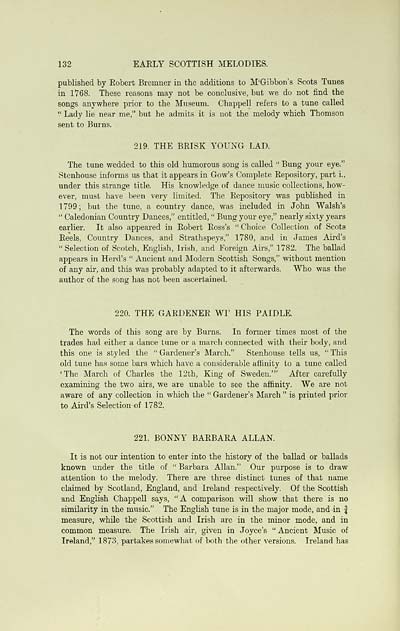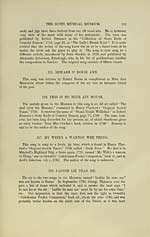Glen Collection of printed music > Printed text > Early Scottish melodies
(154) Page 132 - Brisk young lad
Download files
Complete book:
Individual page:
Thumbnail gallery: Grid view | List view

132 EAELY SCOTTISH MELODIES.
published by Eobert Bremuer in the additions to M'Gibbon's Scots Tunes
in 1768. These reasons may not be conclusive, but we do not find the
songs anywhere prior to the Museum. Chappell refers to a tune called
" Lady lie near me," but he admits it is not the melody which Thomson
sent to Burns.
219. THE BEISK YOUNG LAD.
The tune wedded to this old humorous song is called " Bung your eye."
Stenhouse mforms us that it appears in Gow's Complete Kepository, part i.,
under this strange title. His knowledge of dance music collections, how-
ever, must have been very limited. The Eepository was published in
1799; but the tune, a country dance, was included in John Walsh's
" Caledonian Country Dances," entitled, " Bung your eye," nearly sixty years
earlier. It also appeared in Eobert Eoss's " Choice Collection of Scots
Eeels, Country Dances, and Strathspeys," 1780, and in James Aird's
" Selection of Scotch, English, Irish, and Foreign Airs," 1782. The ballad
appears in Herd's " Ancient and Modern Scottish Songs," without mention
of any air, and this was probably adapted to it afterwards. Who was the
author of the song has not been ascertained.
220. THE GAEDENEE WI' HIS PAIDLE.
The words of this song are by Burns. In former times most of the
trades had either a dance tune or a march connected with their body, and
this one is styled the " Gardener's March." Stenhouse tells us, " This
old tune has some bars which have a considerable affinity to a tune called
'The March of Charles the 12th, King of Sweden.'" After carefully
examining the two airs, we are unable to see the affinity. We are not
aware of any collection in which the " Gardener's March " is printed prior
to Aird's Selection of 1782.
221. BONNY BAEBAEA ALLAN.
It is not our intention to enter into the history of the baUad or ballads
known under the title of " Barbara Allan." Our purpose is to draw
attention to the melody. There are three distinct tunes of that name
claimed by Scotland, England, and Ireland respectively. Of the Scottish
and English Chappell says, "A comparison will show that there is no
similarity in the music." The English tune is in the major mode, and-in f
measure, while the Scottish and Irish are in the minor mode, and in
common measure. The Irish air, given in Joyce's " Ancient Music of
Ireland," 1873, partakes somewhat of both the other versions. Ireland has
published by Eobert Bremuer in the additions to M'Gibbon's Scots Tunes
in 1768. These reasons may not be conclusive, but we do not find the
songs anywhere prior to the Museum. Chappell refers to a tune called
" Lady lie near me," but he admits it is not the melody which Thomson
sent to Burns.
219. THE BEISK YOUNG LAD.
The tune wedded to this old humorous song is called " Bung your eye."
Stenhouse mforms us that it appears in Gow's Complete Kepository, part i.,
under this strange title. His knowledge of dance music collections, how-
ever, must have been very limited. The Eepository was published in
1799; but the tune, a country dance, was included in John Walsh's
" Caledonian Country Dances," entitled, " Bung your eye," nearly sixty years
earlier. It also appeared in Eobert Eoss's " Choice Collection of Scots
Eeels, Country Dances, and Strathspeys," 1780, and in James Aird's
" Selection of Scotch, English, Irish, and Foreign Airs," 1782. The ballad
appears in Herd's " Ancient and Modern Scottish Songs," without mention
of any air, and this was probably adapted to it afterwards. Who was the
author of the song has not been ascertained.
220. THE GAEDENEE WI' HIS PAIDLE.
The words of this song are by Burns. In former times most of the
trades had either a dance tune or a march connected with their body, and
this one is styled the " Gardener's March." Stenhouse tells us, " This
old tune has some bars which have a considerable affinity to a tune called
'The March of Charles the 12th, King of Sweden.'" After carefully
examining the two airs, we are unable to see the affinity. We are not
aware of any collection in which the " Gardener's March " is printed prior
to Aird's Selection of 1782.
221. BONNY BAEBAEA ALLAN.
It is not our intention to enter into the history of the baUad or ballads
known under the title of " Barbara Allan." Our purpose is to draw
attention to the melody. There are three distinct tunes of that name
claimed by Scotland, England, and Ireland respectively. Of the Scottish
and English Chappell says, "A comparison will show that there is no
similarity in the music." The English tune is in the major mode, and-in f
measure, while the Scottish and Irish are in the minor mode, and in
common measure. The Irish air, given in Joyce's " Ancient Music of
Ireland," 1873, partakes somewhat of both the other versions. Ireland has
Set display mode to: Large image | Transcription
Images and transcriptions on this page, including medium image downloads, may be used under the Creative Commons Attribution 4.0 International Licence unless otherwise stated. ![]()
| Special collections of printed music > Glen Collection of printed music > Printed text > Early Scottish melodies > (154) Page 132 - Brisk young lad |
|---|
| Permanent URL | https://digital.nls.uk/91349422 |
|---|---|
| Description | Also: The gardener wi' his paidle. Also: Bonny Barbara Allan |
| Description | Scottish songs and music of the 18th and early 19th centuries, including music for the Highland bagpipe. These are selected items from the collection of John Glen (1833 to 1904). Also includes a few manuscripts, some treatises, and other books on the subject. |
|---|
| Description | The Glen Collection and the Inglis Collection represent mainly 18th and 19th century Scottish music, including Scottish songs. The collections of Berlioz and Verdi collected by bibliographer Cecil Hopkinson contain contemporary and later editions of the works of the two composers Berlioz and Verdi. |
|---|

